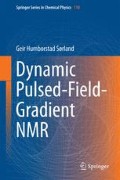Abstract
Instead of letting the magnetization reach thermal equilibrium before each scan, a pulse sequence is presented, which applies a combination of RF-pulses and magnetic field gradients to spoil any magnetization in any direction of a sample located in an external magnetic field to produce a net nuclear magnetization, the spoiler recovery (SR) sequence. The basic assumption made is that the state of the nuclear spins at the end of the sequence is comparable to the state without any external applied magnetic field, i.e. the directions of the nuclear spins are randomly oriented in space. Due to the presence of the external magnetic field, the net nuclear magnetization will re-equilibrate along the external magnetic field due to T1 relaxation processes. Using a wait delay equal to T1 after the spoil process, already 63 % of the magnetization present at thermal equilibrium is regained. The wait time between each scan is then reduced to practically zero, as the ordinary 5 times T1 recycle delay is no longer necessary to achieve identical conditions between the accumulating scans. Using a spoiler recovery delay equal to T1, the total experimental time is reduced by 80 % without any major loss of signal to noise. Likewise, the use of the spoiler recovery approach can reduce the acquisition time of two dimensional experiments, as Diffusion-T2 or T1-T2, from the order of hours to the order of minutes. The SR approach is verified using external magnetic fields ranging from 0.047 to 14.1 T. At the highest fields it is also verified that the SR approach can be used to circumvent effects due to radiation damping. A set of applications using the spoiler recovery approach to reduce the acquisition time will be presented, designed either for low or for high external magnetic field.
Access this chapter
Tax calculation will be finalised at checkout
Purchases are for personal use only
References
P.T. Callaghan, Translational Dynamics and Magnetic Resonance (Oxford University Press, Oxford, 2011), p. 547
W.S. Price, NMR Studies of Translational Motion Principles and Applications (Cambridge University Press, Cambridge, 2010)
T. Stait-Gardner, P.G. Anil Kumar, W.S. Price, Steady state effects in PGSE NMR diffusion experiments. Chem. Phys. Lett. 462(4–6), 331–336 (2008)
J. Mitchell, M.D. Hürlimann, E.J. Fordham, A rapid measurement of T1/T2: the DECPMG sequence. J. Magn. Reson. 200(2), 198–206 (2009)
L. Venturi, K. Wright, B. Hills, Ultrafast T1–T2 relaxometry using FLOP sequences. J. Magn. Reson. 205(2), 224–234 (2010)
M.D. Pelta et al., A one-shot sequence for high-resolution diffusion-ordered spectroscopy. Magn. Reson. Chem. 40(13), S147–S152 (2002)
Y.-Q. Song, X. Tang, A one-shot method for measurement of diffusion. J. Magn. Reson. 170(1), 136–148 (2004)
V.V. Krishnan, N. Murali, Radiation damping in modern NMR experiments: progress and challenges. Prog. Nucl. Magn. Reson. Spectrosc. 68, 41–57 (2013)
R.H. Hashemi, W.G. Bradley, C.J. Lisanti, MRI: The Basics (Wolters Kluwer Health, The Netherlands, 2012)
J.M. Fauth et al., Elimination of unwanted echoes and reduction of dead time in three-pulse electron spin-echo spectroscopy. J. Mag. Reson. 66(1), 74–85 (1986)
N. Bloembergen, R.V. Pound, Radiation damping in magnetic resonance experiments. Phys. Rev. 95(1), 8–12 (1954)
W.S. Price, F. Tsuchiya, Y. Arata, Lysozyme aggregation and solution properties studied using PGSE NMR diffusion measurements. J. Am. Chem. Soc. 121(49), 11503–11512 (1999)
P. Broekaert, J. Jeener, Suppression of radiation damping in NMR in liquids by active electronic feedback. J. Magn. Reson. Ser. A 113(1), 60–64 (1995)
W.E. Maas, F.H. Laukien, D.G. Cory, Suppression of radiation damping by Q switching during acquisition. J. Magn. Reson. Ser. A 113(2), 274–277 (1995)
H. Barjat, D.L. Mattiello, R. Freeman, Suppression of radiation damping in high-resolution NMR. J. Magn. Reson. 136(1), 114–117 (1999)
A.K. Khitrin, A. Jerschow, Simple suppression of radiation damping. J. Magn. Reson. 225, 14–16 (2012)
P.P. Mitra, P.N. Sen, L.M. Schwartz, Short-time behavior of the diffusion coefficient as a geometrical probe of porous media. Phys. Rev. B 47(14), 8565–8574 (1993)
G.H. Sørland, Characterization of emulsions by PFG-NMR. AIP Conf. Proc. 1330(1), 27–30 (2011)
J. Stepišnik, Validity limits of Gaussian approximation in cumulant expansion for diffusion attenuation of spin echo. Phys. B 270(1–2), 110–117 (1999)
G. Grasso, J.J. Titman, Chain folding and diffusion in monodisperse long n-alkanes by solid-state NMR. Macromolecules 42(12), 4175–4180 (2009)
A.G. Palmer, D.J. Patel, Kurt Wüthrich and NMR of biological macromolecules. Structure 10(12), 1603–1604 (2002)
K.F. Morris, C.S. Johnson, Diffusion-ordered two-dimensional nuclear magnetic resonance spectroscopy. J. Am. Chem. Soc. 114(8), 3139–3141 (1992)
C.S. Johnson Jr, Diffusion ordered nuclear magnetic resonance spectroscopy: principles and applications. Prog. Nucl. Magn. Reson. Spectrosc. 34(3–4), 203–256 (1999)
S.W. Provencher, A constrained regularization method for inverting data represented by linear algebraic or integral equations. Comput. Phys. Commun. 27(3), 213–227 (1982)
H.W. Anthonsen, G.H. Sørland, K. Zick, J. Sjoblom, Quantitative recovery ordered (Q-ROSY) and diffusion ordered spectroscopy using the spoiler recovery approach. Diffus. Fundam. 16, 12 (2012)
F. Leal-Calderon, J. Bibette, V. Schmitt, Double Emulsions, in Emulsion Science (Springer, New York), pp. 173–199
Author information
Authors and Affiliations
Corresponding author
Rights and permissions
Copyright information
© 2014 Springer-Verlag Berlin Heidelberg
About this chapter
Cite this chapter
Sørland, G.H. (2014). The Spoiler Recovery Approach (SR). In: Dynamic Pulsed-Field-Gradient NMR. Springer Series in Chemical Physics, vol 110. Springer, Berlin, Heidelberg. https://doi.org/10.1007/978-3-662-44500-6_6
Download citation
DOI: https://doi.org/10.1007/978-3-662-44500-6_6
Published:
Publisher Name: Springer, Berlin, Heidelberg
Print ISBN: 978-3-662-44499-3
Online ISBN: 978-3-662-44500-6
eBook Packages: Chemistry and Materials ScienceChemistry and Material Science (R0)

